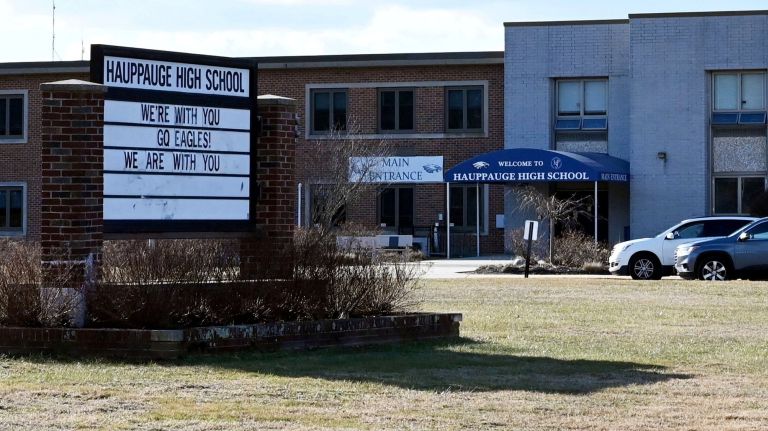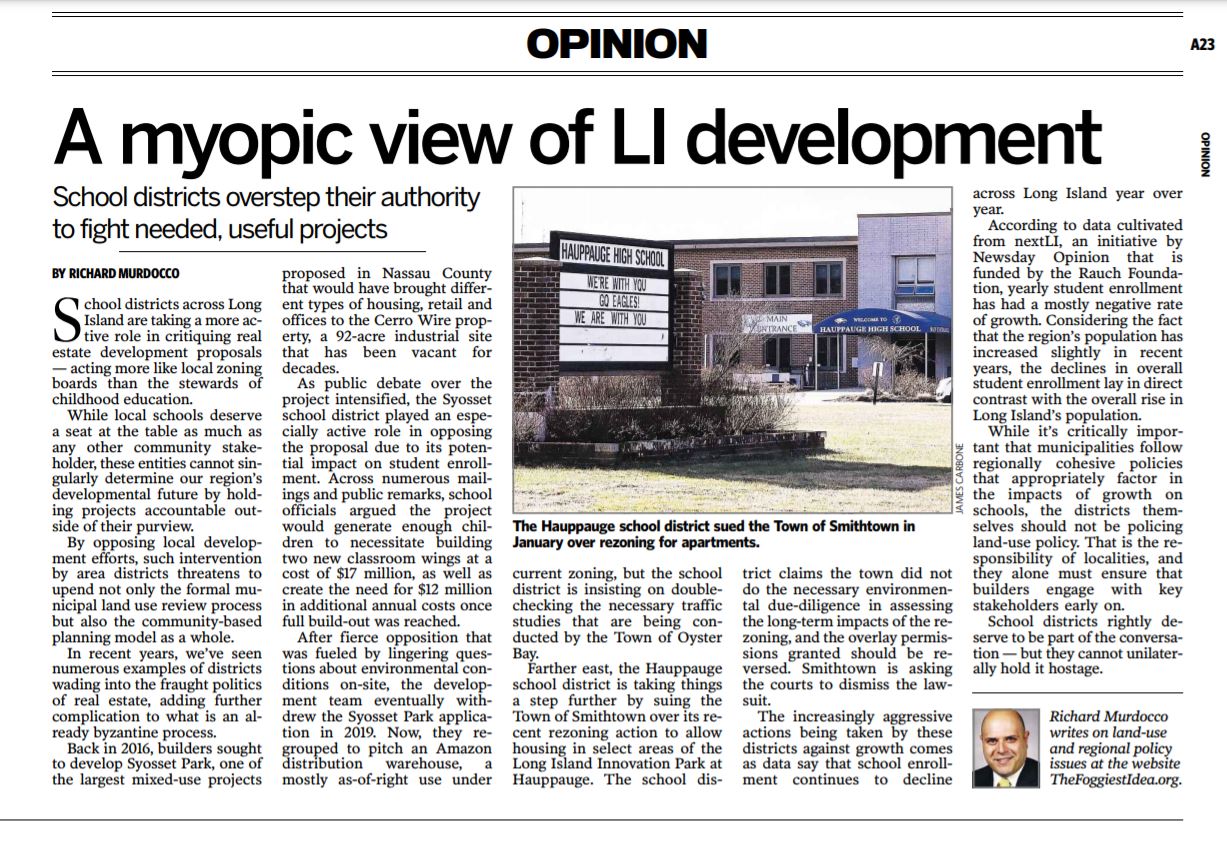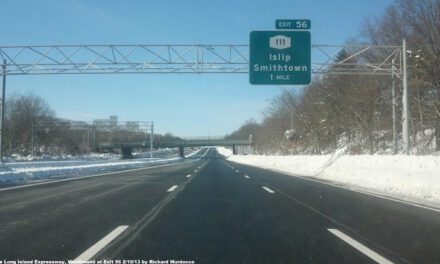The following op-ed was first published in the March 17, 2021 edition of Newsday on page A23. You can read the original here.
School districts overstep their authority to fight needed, useful projects.
By Richard Murdocco
School districts across Long Island are taking a more active role in critiquing real estate development proposals — acting more like local zoning boards than the stewards of childhood education.
While local schools deserve a seat at the table as much as any other community stakeholder, these entities cannot singularly determine our region’s developmental future by holding projects accountable outside of their purview.
By opposing local development efforts, such intervention by area districts threatens to upend not only the formal municipal land use review process but also the community-based planning model as a whole.

Pictured: The Hauppauge school district sued the Town of Smithtown in January over rezoning for apartments. (Photo Credit: James Carbone/Newsday)
In recent years, we’ve seen numerous examples of districts wading into the fraught politics of real estate, adding further complication to what is an already byzantine process.
Back in 2016, builders sought to develop Syosset Park, one of the largest mixed-use projects proposed in Nassau County that would have brought different types of housing, retail and offices to the Cerro Wire property, a 92-acre industrial site that has been vacant for decades.
As public debate over the project intensified, the Syosset school district played an especially active role in opposing the proposal due to its potential impact on student enrollment. Across numerous mailings and public remarks, school officials argued the project would generate enough children to necessitate building two new classroom wings at a cost of $17 million, as well as create the need for $12 million in additional annual costs once full build-out was reached.
After fierce opposition that was fueled by lingering questions about environmental conditions on-site, the development team eventually withdrew the Syosset Park application in 2019. Now, they regrouped to pitch an Amazon distribution warehouse, a mostly as-of-right use under current zoning, but the school district is insisting on double-checking the necessary traffic studies that are being conducted by the Town of Oyster Bay.
Farther east, the Hauppauge school district is taking things a step further by suing the Town of Smithtown over its recent rezoning action to allow housing in select areas of the Long Island Innovation Park at Hauppauge. The school district claims the town did not do the necessary environmental due-diligence in assessing the long-term impacts of the rezoning, and the overlay permissions granted should be reversed. Smithtown is asking the courts to dismiss the lawsuit.
The increasingly aggressive actions being taken by these districts against growth comes as data say that school enrollment continues to decline across Long Island year over year.
According to data cultivated from nextLI, an initiative by Newsday Opinion that is funded by the Rauch Foundation, yearly student enrollment has had a mostly negative rate of growth. Considering the fact that the region’s population has increased slightly in recent years, the declines in overall student enrollment lay in direct contrast with the overall rise in Long Island’s population.
While it’s critically important that municipalities follow regionally cohesive policies that appropriately factor in the impacts of growth on schools, the districts themselves should not be policing land-use policy. That is the responsibility of localities, and they alone must ensure that builders engage with key stakeholders early on.
School districts rightly deserve to be part of the conversation — but they cannot unilaterally hold it hostage.
Richard Murdocco, who writes on Long Island land-use and regional policy issues at TheFoggiestIdea.org, is an adjunct professor of economic development and planning at Stony Brook University.

















Read your opinion piece in Newsday 3/17/21
One thing you and everyone of the real estate crowd wants to develop and develop. Ever think that people moved out to escape overdeveloped Queens and now this urbanization is being stuffed down their throats.
You are spot on. Unfortunately, school districts on Long Island feel empowered to control development, fearing the possible over burdening of their precious districts. This is precisely the reason why Long Island is underserved with housing, and more specifically, multi family rentals. The proposed Hauppauge development is the quintessential example of the short sightedness and ignorance of the districts, and quite frankly, many Long Islanders. We are unable to retain young talent in our work force due to inadequate housing. The town of Smithtown was wise enough to be open minded and allow rentals adjacent to the industrial park in order to help attract talented young employees. As you mention, enrollment continues to decline in districts, including Smithtown. So, what is the problem? Very simply it is NIMBY ignorance. I am a member of the Real Estate institute at SBU. Several years ago we did a study regarding multi family housing developments on Long Island over the last 20 years. The study showed that not only did these developments not have any material crowding effect on the school districts, but it also showed that these developments actually enhanced the value of the adjacent single family homes in these areas. It is a shame that we cannot shake the NIMBY mentality on this island of ours. Typically, the same people who fight developments like the one in Hauppauge will be the same ones who will be the first to complain that their children cannot afford to live here. Amazing.